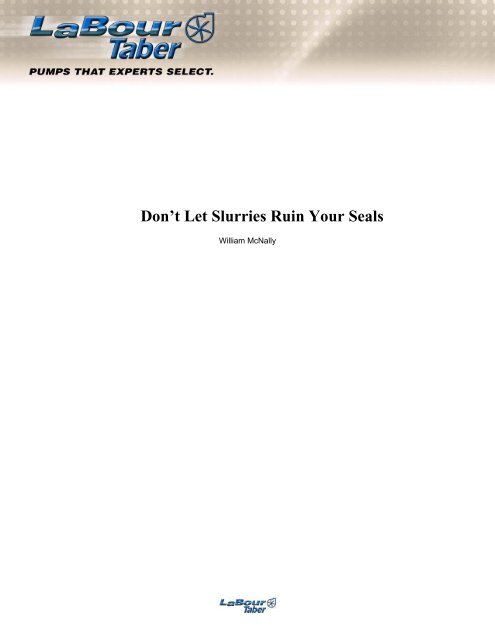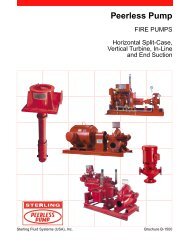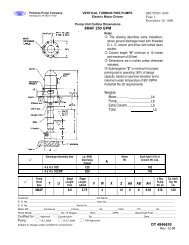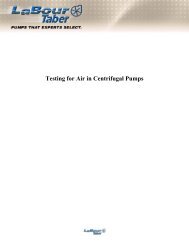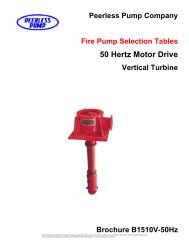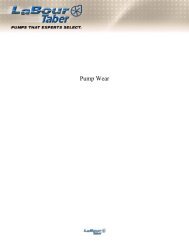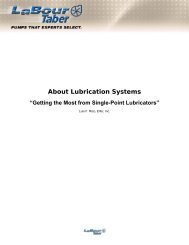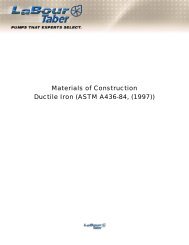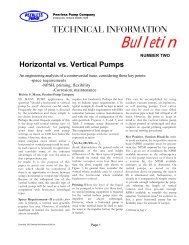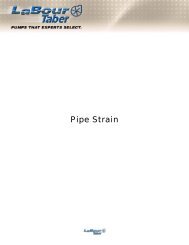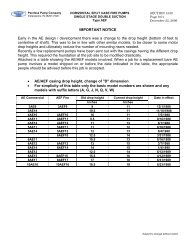Don't Let Slurries Ruin Your Seals - Peerless Pump
Don't Let Slurries Ruin Your Seals - Peerless Pump
Don't Let Slurries Ruin Your Seals - Peerless Pump
You also want an ePaper? Increase the reach of your titles
YUMPU automatically turns print PDFs into web optimized ePapers that Google loves.
Don’t <strong>Let</strong> <strong>Slurries</strong> <strong>Ruin</strong> <strong>Your</strong> <strong>Seals</strong>William McNally
Bad Solution No. 2. Install a cyclone separator instead of a filter. This idea is just as bad as the first. A cyclonewas never intended to be a single-pass device. It works well if used in a bank of several filters, but there is notenough pressure differential between the suction side of a pump and the stuffing box for a cyclone to be effective.Bad Solution No. 3. Place the seal outside the stuffing box so the springs will not be located in the dirty fluid. Theproblem with this idea is that as the seal faces wear, they will move into the dirty fluid. The result will be that themovable face will hang up in the solids and the faces will open. Another downside to this approach is thatcentrifugal force throws the solids into the seal faces instead of away from them.Bad Solution No. 4. Install a double rotating seal in a "back to back" configuration with a higher-pressure, cleanliquid barrier between the seals. This is a very common approach to the problem and presents all of the sameproblems associated with installation of the seal outside the stuffing box. In addition to a rapid failure, you also willexperience product dilution as the barrier fluid leaks into the pump.Bad Solution No. 5. Using two hard faces as a first choice. Needless to say, this will not prevent the faces fromopening, and experience shows that when they do open, you are going to destroy both hard faces. <strong>Don't</strong> believesome salespeople's claims that the seal faces are designed to "grind up" the solid particles into a fine powder.Now, let's look at some methods that work:Good Solution No. 1. Flushing with a clean liquid is an effective way to clean up the pumping fluid. Various fluidscan be used:• the finished, clean product or one of the mixture's clean ingredients;• a compatible fluid;• a solvent;• an additive that will be mixed in downstream and could be injected into the stuffing box location;• clean water; or• a compatible grease (this is suitable with most balanced seals running at lower speeds).Never introduce steam into the stuffing box because it could cause product to flash and the pump to cavitate.Inject flushing fluid at a pressure that is a minimum of 15 psi higher than the stuffing box pressure.Good Solution No. 2. Install an oversized, jacketed sealing chamber and "dead end" the fluid -- that is, makesure that no circulation lines either come into or go out of the sealing chamber.You can use the cooling jacket to remove the heat being generated by the seal faces. Centrifugal force cleans upthe solids that are present in the small amount of fluid trapped in the seal chamber. This solution worksexceptionally well with fluids, such as heat transfer oils, in which temperature control is important.If the fluid you are sealing is not hot, the cooling jacket will not be necessary. Sometimes, a single charge of cleanliquid into an oversized, dead-ended stuffing box is all that is required to seal even severe slurries.If the solids have a lower specific gravity than the liquid, use a clean flush or one filling of a higher specific gravity,compatible liquid.Good Solution No. 3. If the solid particles are sub-micron in size, as is the case with kaolin (china clay) andsome dyes, two seals with a higher-pressure barrier fluid are required. In some instances, you may want to usetwo hard faces on the inner seal.Good Solution No. 4. Install a large seal chamber on the pump and connect a recirculation line from the bottomof the stuffing box to the suction side of the pump. This will cause liquid to flow from behind the impeller to thestuffing box and then on to the suction of the pump. Fluid entering the stuffing box from behind the impeller hasbeen centrifuged and should be a lot cleaner than the fluid you are pumping.This solution works well with closed impeller pumps and those open impeller designs that adjust to the front of thepump volute.
If you elect to use a rotating metal bellows, remember that the bellows should rotate the fluid in the sealingchamber. Most bellows designs allow the thin bellows plates to cut through the abrasive slurry and, therefore, theplates suffer severe wear and breakage in a short period of time.William McNally has more than 45 years of experience with pumps and seals. He runs the McNally Institute(www.mcnallyinstitute.com), which conducts courses on pumps and seals.LaBour <strong>Pump</strong> Company – 901 Ravenwood Drive, Selma, Alabama 36701Ph: (317) 925-9661 - Fax: (317) 920-6605 - www.labourtaber.comA Product of <strong>Peerless</strong> <strong>Pump</strong> CompanyCopyright © 2005 <strong>Peerless</strong> <strong>Pump</strong> Company


